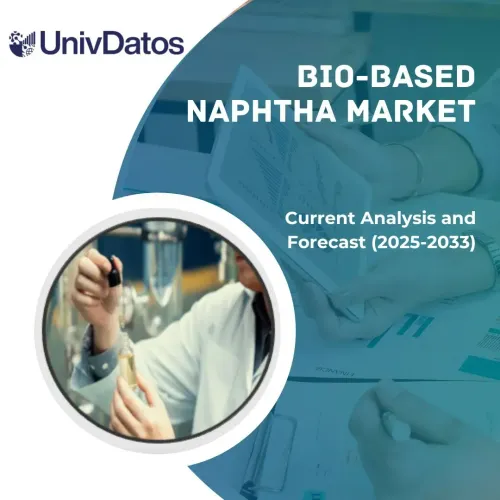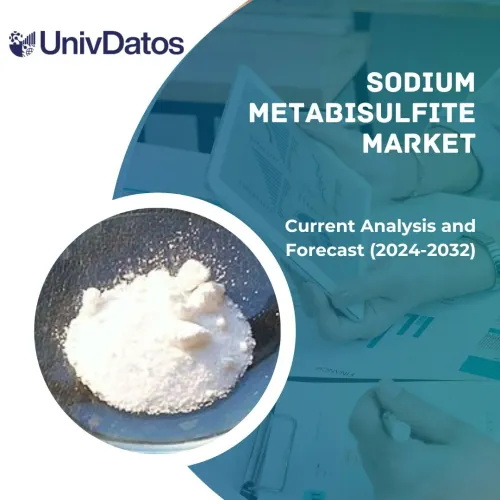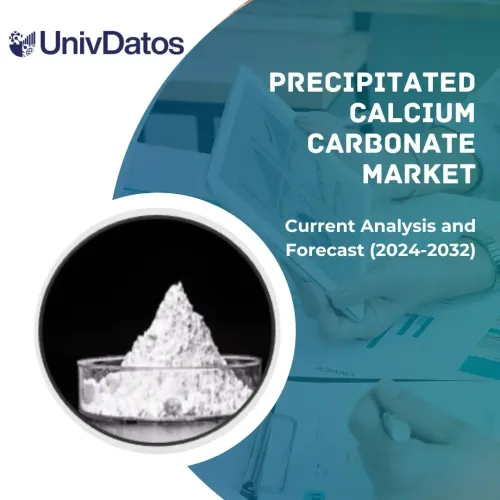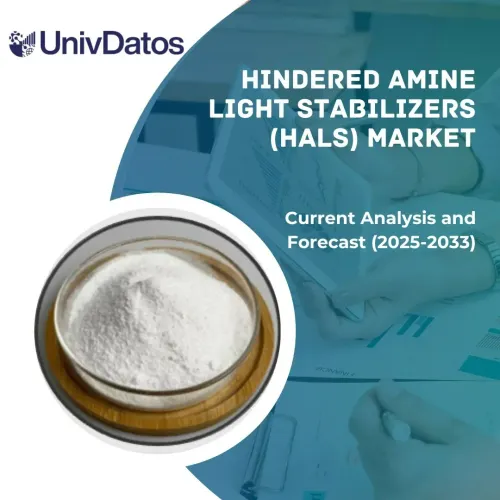Рынок зеленого аммиака: текущий анализ и прогноз (2023-2030)
Акцент на технологиях (щелочной электролиз воды, мембрана для обмена протонами и твердооксидный электролиз); Конечный пользователь (промышленное сырье, выработка электроэнергии, транспорт, прочее); и регион/страна
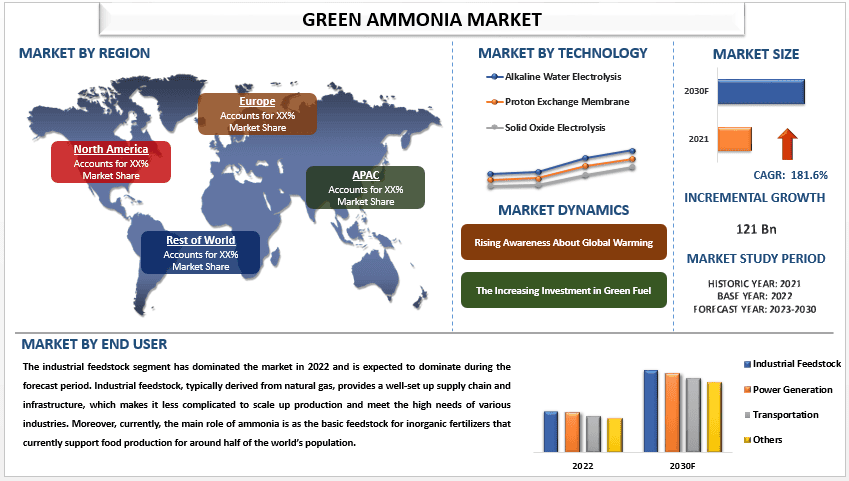
Объем рынка зеленого аммиака в 2022 году оценивался в 46,08 млн долларов США, и ожидается, что он будет расти со среднегодовым темпом роста (CAGR) 186,1% в период с 2023 по 2030 год. Увеличение инвестиций в зеленое топливо, вероятно, будет стимулировать рынок зеленого аммиака.Зеленый аммиак, который производится с использованием возобновляемых источников энергии и не выделяет выбросов углерода при сгорании, стал жизнеспособным и экологически чистым вариантом топлива. Растущие инвестиции в зеленое топливо позволяют улучшить эффективные и экономически эффективные технологии и инфраструктуру для производства, хранения и использования зеленого аммиака. Это, в свою очередь, стимулирует общий рост рынка зеленого аммиака, привлекая больше заинтересованных сторон, инвесторов и участников отрасли. Кроме того, по данным Управления энергетической информации США, к 2050 году общемировое потребление энергии, как ожидается, вырастет почти на 50%, при этом лидируют ископаемые виды топлива, но спрос на возобновляемые источники энергии также взрывно растет. Появление зеленой энергетики в сочетании с растущей обеспокоенностью по поводу изменения климата во всем мире создает огромные инвестиционные возможности. Вода, ветер и солнце являются одними из основных источников возобновляемой энергии. Поэтому с производством зеленого аммиака возобновляемую энергию можно хранить и повторно использовать для выработки электроэнергии в точках потребления. Это сделает выработку возобновляемой энергии более эффективной и пригодной для долгосрочного использования. Тем самым создавая возможности для роста рынка зеленого аммиака.Например, в августе 2022 года CF Industries Holdings, Inc. объявила, что оценивает площадку в округе Ассеншен для строительства предлагаемого завода по производству голубого аммиака стоимостью 2 миллиарда долларов. Это будет еще одним важным шагом на пути к нашей цели — сделать Луизиану углеродно-нейтральной к 2050 году.Поэтому увеличение инвестиций в зеленое топливо стимулирует рынок зеленого аммиака в прогнозный период.
Некоторые из основных игроков, работающих на рынке, включают Siemens Energy, Air Liquide, Engie, Uniper SE, Air Products Inc., Cummins Inc., Toshiba Energy System & Solution Corporation, Nel ASA, Linde plc, Green Hydrogen System.
Информация, представленная в отчете
«Среди технологий щелочной электролиз воды доминировал на рынке зеленого аммиака в 2022 году»
В зависимости от технологии рынок делится на щелочной электролиз воды, мембрану для обмена протонами и твердооксидный электролиз. Среди них щелочной электролиз воды доминировал в производстве зеленого аммиака и, как ожидается, продемонстрирует ту же тенденцию в прогнозный период. Щелочной электролиз воды является одним из наиболее распространенных типов технологий, используемых для разделения воды на газы водорода и кислорода, в котором используется раствор гидроксида калия (KOH) и никелевый катод, и он является наиболее широко используемым методом производства зеленого аммиака благодаря своей простоте, зрелости и экономичности. Значительные поставки KOH и налаженная сеть поставщиков этого химического вещества снизили производственные цены и улучшили масштабируемость. В то время как другие методы электролиза, в том числе мембрана для обмена протонами (PEM) и твердооксидный электролиз (SOE), являются перспективными, они сталкиваются с проблемами, связанными с более высокими рабочими температурами, коррозионной стойкостью и проблемами масштабирования, что исключает их массовое применение.Например, в 2022 году правительство Квинсленда предоставило координированный статус проекта предложению стоимостью 4,7 миллиарда долларов США по строительству завода по производству зеленого водорода и аммиака в Гладстоне. Проект включает планы по строительству до 3 гигаватт электролиза и производству до 5000 тонн зеленого аммиака в день. Он будет питаться на 100% возобновляемой энергией от новых солнечных и ветровых электростанций.
«Среди конечных пользователей сегмент промышленного сырья доминировал на рынке в 2022 году»
В зависимости от конечных пользователей рынок сегментирован на промышленное сырье, выработку электроэнергии, транспорт и прочее. Среди них сегмент промышленного сырья доминировал на рынке в 2022 году и, как ожидается, будет доминировать в течение прогнозного периода. Промышленное сырье, обычно получаемое из природного газа, обеспечивает хорошо налаженную цепочку поставок и инфраструктуру, что упрощает масштабирование производства и удовлетворение высоких потребностей различных отраслей. Кроме того, в настоящее время основная роль аммиака — это базовое сырье для неорганических удобрений, которые в настоящее время обеспечивают производство продовольствия примерно для половины населения мира. Около 70% аммиака используется для производства удобрений, а остальное используется для широкого спектра промышленных применений, таких как пластмассы, взрывчатые вещества и синтетические волокна. Кроме того, во-вторых, цена производства зеленого аммиака из промышленного сырья, как правило, меньше по сравнению с различными возобновляемыми источниками, включая биомассу или солнечную энергию, что делает его более экономически выгодным для массового производства. Например, в марте 2022 года Mitsui & Co., Ltd. и CF Industries объявили о планах по созданию новых мощностей по производству голубого аммиака в Соединенных Штатах. Новый завод будет производить голубой аммиак, используя процессы улавливания и секвестрования углерода, чтобы сократить выбросы углерода более чем на 60% по сравнению с обычным аммиаком.
«Европа доминировала на рынке зеленого аммиака в 2022 году»
Европа доминировала и, как ожидается, будет доминировать на рынке зеленого аммиака благодаря растущей осведомленности об использовании экологически чистых альтернатив, растущему применению зеленого аммиака в различных секторах и нескольким благоприятным правительственным инициативам, которые стимулируют рынок зеленого аммиака в прогнозный период. С ростом уровня грамотности во всем мире среди потребителей и отраслей наблюдается растущее понимание необходимости экологически чистых вариантов, что привело к всплеску спроса на зеленый аммиак, производимый из возобновляемых источников энергии, которые включают ветер, солнце или гидроэлектричество, что делает его более чистой альтернативой традиционным методам производства аммиака. Кроме того, зеленый аммиак ориентирован на многочисленные отрасли, включая удобрения, фармацевтику, сельское хозяйство и хранение энергии. Например, зеленый аммиак используется в качестве носителя чистой энергии, что позволяет транспортировать возобновляемую энергию на большие расстояния без потери производительности и эффективности. Хотя его можно использовать в качестве универсального промежуточного продукта в химических реакциях, позволяющем производить различные продукты, включая пластмассы, красители и фармацевтические препараты. Эти пакеты вносят существенный вклад в сокращение выбросов углерода и содействие устойчивому развитию. Например, в июне 2022 года консорциум в составе Shell, ITM Power и Johnson Matthey объявил о планах строительства крупного предприятия по производству зеленого аммиака в Великобритании. Проект направлен на выработку 50 мегаватт электроэнергии посредством электролиза и преобразование ее в зеленый аммиак для использования в различных областях.
Охват отчета по рынку зеленого аммиака
Атрибут отчета | Детали |
Базовый год | 2022 |
Прогнозный период | 2023-2030 |
Динамика роста | Ускорение со среднегодовым темпом роста 186,1% |
Размер рынка 2022 | 46,08 млн долларов США |
Региональный анализ | Северная Америка, Европа, APAC, Остальной мир |
Основные регионы-участники | Ожидается, что Европа будет расти с самым высоким среднегодовым темпом роста в течение прогнозируемого периода |
Основные охватываемые страны | США, Канада, Германия, Великобритания, Франция, Нидерланды, Швейцария, Китай, Южная Корея, Япония |
Профили компаний | Siemens, Thyssenkrupp, Nel Hydrogen, Green Hydrogen Systems, MAN Energy Solutions, Uniper, BASF, Enapter, ENGIE, Hiringa Energy, BASF, Enaex SA и JGC Holding Corporation |
Объем отчета | Тенденции рынка, движущие силы и ограничения; Оценка и прогноз выручки; Анализ сегментации; Влияние COVID-19; Анализ спроса и предложения; Конкурентная среда; Профилирование компаний |
Охваченные сегменты | По технологии; По конечному пользователю и по региону/стране |
Причины для покупки этого отчета:
- Исследование включает в себя анализ размеров рынка и прогнозирования, подтвержденный аутентифицированными ключевыми экспертами отрасли.
- В отчете представлен краткий обзор общей производительности отрасли с первого взгляда.
- Отчет содержит углубленный анализ выдающихся представителей отрасли с основным акцентом на ключевые финансовые показатели бизнеса, портфели продуктов, стратегии расширения и последние разработки.
- Подробное изучение движущих сил, ограничений, ключевых тенденций и возможностей, преобладающих в отрасли.
- Исследование всесторонне охватывает рынок по различным сегментам.
- Углубленный анализ отрасли на региональном уровне.
Варианты настройки:
Глобальный рынок зеленого аммиака может быть дополнительно настроен в соответствии с требованиями или любым другим сегментом рынка. Кроме того, UMI понимает, что у вас могут быть свои собственные бизнес-потребности, поэтому не стесняйтесь обращаться к нам, чтобы получить отчет, который полностью соответствует вашим требованиям.
Содержание
Методология исследования для анализа зеленого аммиака (2023-2030)
Анализ исторического рынка, оценка текущего рынка и прогнозирование будущего рынка мирового рынка зеленого аммиака были тремя основными этапами, предпринятыми для создания и анализа внедрения зеленого аммиака в основных регионах мира. Было проведено исчерпывающее вторичное исследование для сбора исторических рыночных показателей и оценки текущего размера рынка. Во-вторых, для подтверждения этих данных было учтено множество результатов и предположений. Кроме того, были проведены исчерпывающие первичные интервью с отраслевыми экспертами по всей цепочке создания стоимости мирового рынка зеленого аммиака. После предположения и проверки рыночных показателей посредством первичных интервью мы применили подход «сверху вниз / снизу вверх» для прогнозирования полного размера рынка. После этого были приняты методы разбивки рынка и триангуляции данных для оценки и анализа размера рынка сегментов и подсегментов отрасли. Подробная методология объясняется ниже:
Анализ исторического размера рынка
Этап 1: Углубленное изучение вторичных источников:
Детальное вторичное исследование было проведено для получения исторического размера рынка зеленого аммиака из внутренних источников компании, таких какгодовые отчеты и финансовая отчетность, презентации о результатах деятельности, пресс-релизы и т. д.,и внешние источники, включаяжурналы, новости и статьи, правительственные публикации, публикации конкурентов, отраслевые отчеты, сторонние базы данных и другие авторитетные публикации.
Этап 2: Сегментация рынка:
После получения исторических данных о размере рынка зеленого аммиака мы провели детальный вторичный анализ для сбора исторических рыночных данных и доли для различных сегментов и подсегментов для основных регионов. Основные сегменты включены в отчет, такие как технология и конечные пользователи. Далее были проведены анализы на уровне стран для оценки общего внедрения моделей тестирования в этом регионе.
Этап 3: Факторный анализ:
После получения исторического размера рынка различных сегментов и подсегментов мы провели детальныйфакторный анализдля оценки текущего размера рынка зеленого аммиака. Далее мы провели факторный анализ с использованием зависимых и независимых переменных, таких как технология и конечные пользователи рынка зеленого аммиака. Был проведен тщательный анализ сценариев спроса и предложения с учетом ведущих партнерств, слияний и поглощений, расширения бизнеса и запусков продуктов в секторе рынка зеленого аммиака по всему миру.
Оценка и прогноз текущего размера рынка
Оценка текущего размера рынка:Основываясь на практических данных, полученных на вышеуказанных 3 этапах, мы пришли к текущему размеру рынка, ключевым игрокам на мировом рынке зеленого аммиака и рыночным долям сегментов. Все необходимые доли в процентах и разбивки рынка были определены с использованием вышеупомянутого вторичного подхода и были подтверждены посредством первичных интервью.
Оценка и прогнозирование:Для оценки и прогнозирования рынка были присвоены веса различным факторам, включая движущие силы и тенденции, ограничения и возможности, доступные для заинтересованных сторон. После анализа этих факторов были применены соответствующие методы прогнозирования, т. е. подход «сверху вниз / снизу вверх», для получения рыночного прогноза на 2030 год для различных сегментов и подсегментов на основных рынках мира. Методология исследования, принятая для оценки размера рынка, включает:
- Размер рынка отрасли с точки зрения выручки (USD) и скорость внедрения рынка зеленого аммиака на основных рынках внутри страны
- Все доли в процентах, разбивки и деления рыночных сегментов и подсегментов
- Ключевые игроки на мировом рынке зеленого аммиака с точки зрения предлагаемых продуктов. Также стратегии роста, принятые этими игроками для конкуренции на быстрорастущем рынке
Проверка размера и доли рынка
Первичное исследование:Были проведены углубленные интервью с ключевыми лидерами общественного мнения (KOL), включая руководителей высшего звена (CXO/VP, руководитель отдела продаж, руководитель отдела маркетинга, руководитель операционного отдела, региональный руководитель, руководитель страны и т. д.) в основных регионах. Затем результаты первичного исследования были обобщены, и был проведен статистический анализ для доказательства выдвинутой гипотезы. Данные первичного исследования были объединены с вторичными данными, таким образом, превращая информацию в практические данные.
Разделение первичных участников по различным регионам
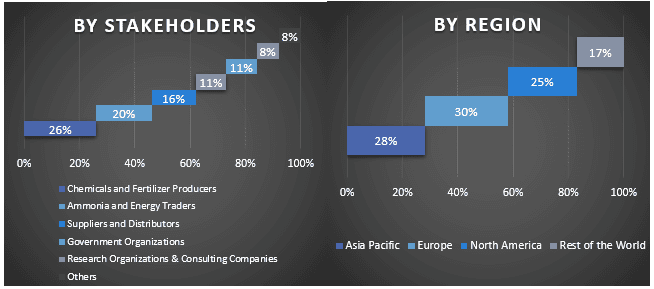
Инжиниринг рынка
Метод триангуляции данных был использован для завершения общей оценки рынка и получения точных статистических данных для каждого сегмента и подсегмента мирового рынка зеленого аммиака. Данные были разделены на несколько сегментов и подсегментов после изучения различных параметров и тенденций в областях технологии и конечного пользователя на мировом рынке зеленого аммиака.
Основная цель исследования глобального зеленого аммиака
В исследовании были определены текущие и будущие рыночные тенденции мирового рынка зеленого аммиака. Инвесторы могут получить стратегические идеи, чтобы основывать свои решения об инвестициях на качественном и количественном анализе, проведенном в исследовании. Текущие и будущие рыночные тенденции определили общую привлекательность рынка на региональном уровне, предоставляя платформу для участников отрасли для использования неиспользованного рынка, чтобы извлечь выгоду из преимущества первого, кто вышел на рынок. Другие количественные цели исследований включают:
- Анализ текущего и прогнозируемого размера рынка зеленого аммиака с точки зрения стоимости (USD). Также анализ текущего и прогнозируемого размера рынка различных сегментов и подсегментов
- Сегменты в исследовании включают области технологии и конечного пользователя
- Определение и анализ нормативно-правовой базы для отрасли зеленого аммиака
- Анализ цепочки создания стоимости, связанной с присутствием различных посредников, а также анализ поведения клиентов и конкурентов отрасли
- Анализ текущего и прогнозируемого размера рынка зеленого аммиака для основных регионов
- Основные страны регионов, изученные в отчете, включают Азиатско-Тихоокеанский регион, Европу, Северную Америку и остальной мир
- Профили компаний рынка зеленого аммиака и стратегии роста, принятые участниками рынка для выживания на быстрорастущем рынке
- Углубленный анализ отрасли на региональном уровне
Связанные Отчеты
Клиенты, купившие этот товар, также купили

